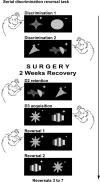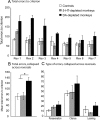Dopamine, but not serotonin, regulates reversal learning in the marmoset caudate nucleus
- PMID: 21411670
- PMCID: PMC3083841
- DOI: 10.1523/JNEUROSCI.5066-10.2011
Dopamine, but not serotonin, regulates reversal learning in the marmoset caudate nucleus
Abstract
Studies of visual discrimination reversal learning have revealed striking neurochemical dissociations at the level of the orbitofrontal cortex (OFC) with serotoninergic, but not dopaminergic, integrity being important for successful reversal learning. These findings have considerable implications for disorders such as obsessive compulsive disorder and schizophrenia, in which reversal learning is impaired, and which are primarily treated with drugs targeting the dopaminergic and serotoninergic systems. Dysfunction in such disorders however, is not limited to the OFC and extends subcortically to other structures implicated in reversal learning, such as the medial caudate nucleus. Therefore, because the roles of the serotonin and dopamine within the caudate nucleus are poorly understood, this study compared the effects of selective serotoninergic or selective dopaminergic depletions of the marmoset medial caudate nucleus on serial discrimination reversal learning. All monkeys were able to learn novel stimulus-reward associations but, unlike control monkeys and monkeys with selective serotoninergic medial caudate depletions, dopamine-depleted monkeys were markedly impaired in their ability to reverse this association. This impairment was not perseverative in nature. These findings are the opposite of those seen in the OFC and provide evidence for a neurochemical double dissociation between the OFC and medial caudate in the regulation of reversal learning. Although the specific contributions of these monoamines within the OFC-striatal circuit remain to be elucidated, these findings have profound implications for the development of drugs designed to remediate some of the cognitive processes underlying impaired reversal learning.
Figures



References
-
- Abdul-Monim Z, Reynolds GP, Neill JC. The atypical antipsychotic ziprasidone, but not haloperidol, improves phencyclidine-induced cognitive deficits in a reversal learning task in the rat. J Psychopharmacol. 2003;17:57–65. - PubMed
-
- Adams KH, Hansen ES, Pinborg LH, Hasselbalch SG, Svarer C, Holm S, Bolwig TG, Knudsen GM. Patients with obsessive-compulsive disorder have increased 5-HT2A receptor binding in the caudate nuclei. Int J Neuropsychopharmacol. 2005;8:391–401. - PubMed
-
- Alex KD, Yavanian GJ, McFarlane HG, Pluto CP, Pehek EA. Modulation of dopamine release by striatal 5-HT2C receptors. Synapse. 2005;55:242–251. - PubMed
-
- Arakawa R, Okumura M, Ito H, Seki C, Takahashi H, Takano H, Nakao R, Suzuki K, Okubo Y, Halldin C, Suhara T. Quantitative analysis of norepinephrine transporter in the human brain using PET with (S,S)-18F-FMeNER-D2. J Nucl Med. 2008;49:1270–1276. - PubMed
Publication types
MeSH terms
Substances
Grants and funding
LinkOut - more resources
Full Text Sources
